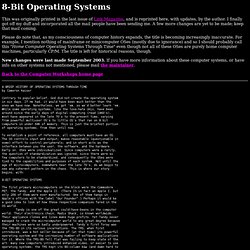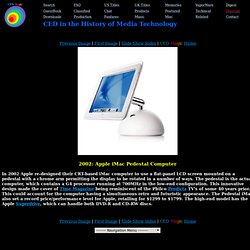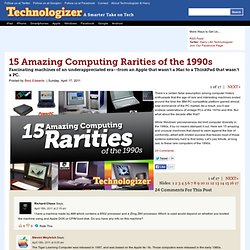

Computer Timeline. The DigiBarn Computer Museum. Classic Computer Magazine Archive. Operating Systems Through Time (8-bits) This was originally printed in the last issue of Link Magazine, and is reprinted here, with updates, by the author.

I finally got off my duff and incorporated all the mail people have been sending me. A few more changes are yet to be made; keep that mail coming. Please do note that, as my consciousness of computer history expands, the title is becoming increasingly inaccurate. For example, I mention nothing of mainframe or minicomputer OSes (mostly due to ignorance) and so I should probably call this "Home Computer Operating Systems Through Time" even though not all of these OSes are purely home computer machines, particularly CP/M. The title is left for historical reasons, though. New changes were last made September 2003. Back to the Computer Workshops home page A BRIEF HISTORY OF OPERATING SYSTEMS THROUGH TIME by Cameron Kaiser Contrary to popular belief, God did not create the operating system in six days. The Original Disc Sleeve Archive XXX. Apple iMac Pedestal Computer in 2002. Previous Image | First Image | Slide Show Index | CED Magic Home 2002: Apple iMac Pedestal Computer In 2002 Apple re-designed their CRT-based iMac computer to use a flat-panel LCD screen mounted on a pedestal with a chrome arm permitting the display to be rotated in a number of ways.

The pedestal is the actual computer, which contains a G4 processor running at 700MHz in the low-end configuration. This innovative design made the cover of Time Magazine being reminiscent of the Philco Predicta TV's of some 40 years prior. This could account for the computer having a simultaneous retro and futuristic appearance. Radio Shack Catalogs.
15 Amazing Computing Rarities of the 1990s. Fascinating machines of an underappreciated era--from an Apple that wasn't a Mac to a ThinkPad that wasn't a PC.

There’s a certain false assumption among computer history enthusiasts that the age of rare and interesting machines ended around the time the IBM PC-compatible platform gained almost total dominance of the PC market. As a result, you’ll see endless celebrations of vintage PCs of the 1970s and 80s. But what about the decade after that? While Windows’ pervasiveness did limit computer diversity in the 1990s, it by no means stamped it out. Here are 15 amazing and unusual machines that dared to swim against the tide of conformity–albeit with limited success that leaves most of these systems extremely hard to find today. The Retrogaming and Retrocomputing Blogazine. PC History. MITS ALTAIR 8800. The story of the first true personal computer has many versions.

It is over 20 years since the debut of the Altair 8800 computer in the pages of Popular Electronics Magazine, but everyone connected with it tells a completely different story. Truly, "Success has many fathers. " I (Stan Veit ) was the first (and last) Computer Editor of Popular Electronics magazine, and I came on the scene after the fact, but as one of the few people who was friendly with all of the participants, I am as qualified as anyone to tell the story. The principals in the story are : Leslie Solomon, former technical director of Popular Electronics, who is often called "The Father of the Personal Computer" (Les himself says he was more like the midwife.)
Arthur Salsberg, editorial director of Popular Electronics, who was responsible for publishing the articles that brought the Altair to the world, Ed Roberts, the president of MITS Incorporated, who designed and built the Altair. "Computer," she answered.